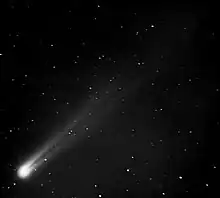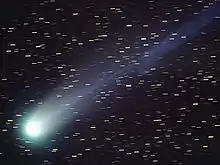 The comet on 16 February 1941 by Yerkes Observatory | |
| Discovery[1] | |
|---|---|
| Discovered by | Reginald Purdon de Kock, John S. Paraskevopoulos |
| Discovery date | 15 January 1941 |
| Orbital characteristics[2] | |
| Epoch | 1941-Feb-15.0 |
| Observation arc | 241 days |
| Aphelion | 1,760 AU |
| Perihelion | 0.79 AU |
| Eccentricity | 0.9991 |
| Inclination | 168.2° |
| 43.1° | |
| Argument of periapsis | 268.7° |
| Last perihelion | 27 January 1941 |
Comet de Kock–Paraskevopoulos (also known with the designations C/1941 B2, 1941 IV, 1941c) is a non-periodic comet discovered on 15 January 1941. The comet reached an apparent magnitude of about +2.[3]
The comet was first observed by Reginald Purdon de Kock in Paarl, South Africa while he was observing variable star R Lupi on 15 January 1942 and notified the Royal Observatory. He estimated the comet had a magnitude of 5.8 and its tail was half a degree long.[1] The comet was independently discovered by Frank Skjellerup in Melbourne on 20 January and confirmed the discovery the next day, while a person named Barnes also notified Melbourne Observatory about the comet on 21 January.[1] John S. Paraskevopoulos of the Harvard College Observatory in Bloemfontein, unaware of the other discoveries, found the comet on 23 January and sent immediately a radiogram in Harvard College, and thus the comet became known in the United States as comet Paraskevopoulos.[1]
The comet brightened rapidly to a magnitude of 2 to 3 the next days, while its tail was reported to be about 5 degrees long. The comet reached its perihelion on 27 January and two days later was the closest approach to Earth, at a distance of 0.2655 AU. On 27 January the comet also reached its southernmost declination, at -57°.[1] On that day, Harley Weston Wood reported a magnitude of 3.26 at a tail length of 5° by naked eye. The comet brightened a bit more the following days, with Ronald Alexander McIntosh reporting magnitude 2.2 and a tail length of 6 degrees on 31 January.[1]
In February the comet began to fade, as it was moving away both from Earth and the Sun.[1] The tail appeared bent the first days of the month. By the mid of February the comet had faded to a magnitude of about 5 and stopped being visible with naked eye.[4] In March the solar elongation decreased and the comet passed 0.6 degrees from the Sun on April 28. The comet was recovered on 4 July by George van Biesbroeck and was last detected on 27 September 1941.[1]
References
- 1 2 3 4 5 6 7 8 Kronk, Gary W. (2009). Cometography: a catalogue of comets. Cambridge: Cambridge University Press. pp. 126–132. ISBN 9780521585071.
- ↑ "Small-Body Database Lookup: C/1941 B2 (de Kock-Paraskevopoulos)". ssd.jpl.nasa.gov. Retrieved 21 August 2023.
- ↑ "Brightest comets seen since 1935". www.icq.eps.harvard.edu. Retrieved 21 August 2023.
- ↑ Bortle, John. "THE BRIGHT-COMET CHRONICLES". www.icq.eps.harvard.edu. Retrieved 19 August 2023.

.png.webp)